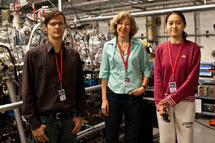
Handy Links
SLAC News Center
SLAC Today
- Subscribe
- Archives: Feb 2006-May 20, 2011
- Archives: May 23, 2011 and later
- Submit Feedback or Story Ideas
- About SLAC Today
SLAC News
Lab News
- Interactions
- Lightsources.org
- ILC NewsLine
- Int'l Science Grid This Week
- Fermilab Today
- Berkeley Lab News
- @brookhaven TODAY
- DOE Pulse
- CERN Courier
- DESY inForm
- US / LHC
SLAC Links
- Emergency
- Safety
- Policy Repository
- Site Entry Form

- Site Maps
- M & O Review
- Computing Status & Calendar
- SLAC Colloquium
- SLACspeak
- SLACspace
- SLAC Logo
- Café Menu
- Flea Market
- Web E-mail
- Marguerite Shuttle
- Discount Commuter Passes
-
Award Reporting Form
- SPIRES
- SciDoc
- Activity Groups
- Library
Stanford
Around the Bay
First Scientific Paper from LCLS Explores Molecules' Interaction with Ultrashort, Ultrafast X-ray Pulses
The first published scientific results from experiments at SLAC's Linac Coherent Light Source are out!
The report, published today in Physical Review Letters, is the first look at how molecules respond to ultrafast pulses of ultra-bright light from the world's most powerful X-ray laser.
The results were surprising, according to lead author Matthias Hoener, a postdoctoral researcher from Western Michigan University who was part of a team led by WMU physicist Nora Berrah. He said they should be helpful to scientists who are trying to figure out how to use the LCLS's strobe-like pulses to make images and stop-action movies of individual atoms and molecules and their behavior.
As Hoener explains it, imaging molecules with the LCLS will require a balance between crisp and bright. If the laser pulses are too long, they'll damage the molecule before the snapshot is taken and the image will be blurry; if they're not intense enough, the image will be faint.
Another challenge: The LCLS forms images by scattering laser light off an atom or molecule. Yet when the LCLS X-rays are tightly focused by mirrors, each powerful laser pulse destroys any sample it hits. So the trick is to gather enough information to compose a snapshot in the split-second before that disintegration takes place.
Berrah's team of 26 scientists from the United States, Germany and Finland spent five days conducting experiments at the LCLS last October. Their goal was to see how the LCLS pulses interacted with simple molecules of nitrogen gas, which consist of two nitrogen atoms bound together.
The researchers bombarded puffs of nitrogen gas with laser pulses that ranged in duration from about four femtoseconds to 280 femtoseconds. A femtosecond is one quadrillionth of a second; the shortest pulses were so short, Hoener said, that the LCLS scientists had no way to measure exactly how short they were.
No matter how short or long it was, though, each pulse contained the same amount of energy in the form of X-ray light; so you might expect that they would have roughly the same effects on the nitrogen molecules.
But to the team's surprise, that was not the case, Hoener said. The long pulses stripped every single electron from the nitrogen molecules, starting with the ones closest to the nucleus. The short ones stripped off only some of them.
Their report attributes this to the "frustrated absorption effect": Since the molecule's electrons are preferentially stripped from the innermost shells, there is simply not enough time during a short pulse for the molecule's outermost electrons to refill the innermost shells and be stripped off.
"We just introduced molecules into the chamber and looked at what was coming out there, and we found surprising new science," Hoener said. "Now we know that by reducing the pulse length, the interaction with the molecule becomes less violent." Understanding this interaction will have a direct bearing on future studies of molecular structures and their chemical dynamics.
Hoener, who also carries out research with Berrah at Lawrence Berkeley National Laboratory's Advanced Light Source, arrived at SLAC last summer to help commission the Atomic, Molecular and Optical science instrument, or AMO, that the team would use for the experiments. The experiments themselves were challenging and intense, he said. The team worked in shifts around the clock, carefully arranging the schedule so each shift would include people to run the experiment, analyze data, and think about the data "and what could be the next step, because the time we had was very, very short. We had tough decisions to make from time to time. This was a very intense discussion and very fruitful and, in the end, very successful. It was a feeling of being a pioneer.''
He said the team was also surprised and gratified that the LCLS scientists were able to provide much shorter laser pulses than they had anticipated for the first few experiments.
"I would say the shortest pulses you could get would be perfect," he said. "But of course by reducing the pulse length you reduce the intensity, so the images become a little faint. So it's kind of a tradeoff between intensity and pulse duration. But I think this is a question that will just have to be explored."
Read a profile of Berrah's work on the Western Michigan University Web site.
óGlennda Chui
SLAC Today, June 23, 2010
